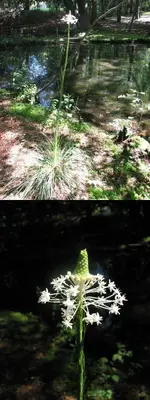Don in SJ
Silver Member
- Joined
- May 20, 2005
- Messages
- 4,937
- Reaction score
- 852
- Golden Thread
- 0
- Detector(s) used
- MINELAB SE Pro
- Primary Interest:
- All Treasure Hunting
- #1
Thread Owner
Well, I know what it is and will provide some clues here, the photos were taken yesterday, and if the deer do not eat the flower head, I hope to get a nice shot when it is in full bloom.
Here is what is said about this Lily on a website, very interesting, it bascally needs forest fires to bloom regulary! I transplanted this Lily next to my pond about 8 years ago and this is only the second time it has produced a flower!
The ______________________ dense clusters of creamy, starlike flowers bloom from May to July.
Flowering on stalks two to three feet high, they are tough, elegant lilies. Their lovely flowers have a sweet nectar that attracts insects and hummingbirds.
The plant is sometimes called _____________, because in spring _________seek out and eat the roots and tender young leaves.
The leaves are thin (grass-like), elongated and up to two feet long. They form a tussock at the base of the plant.
The genus name, xerophyllum, is from the Greek words xeros ("dry") and phyllon ("leaf") and refers to the dry, wiry leaves that compose that tussock.
Flowers mature into fruit capsules with varying numbers of seeds.
The flower stalk dies after fruiting, but the tussock of leaves remains green throughout the winter.
Fire-control practices have helped make them hard to find in some areas. In the absence of a fire, relatively few ____________ plants produce flowers each year.
Don
The Naional Geographic reports that after a fire, however, they need only a year to recover before blooming.
NatureServe, a non-profit conservation organization, reports that they are ranked "vulnerable" in North Carolina and Tennessee. They are ranked as critically imperiled in South Carolina, Georgia, Alabama and West Virginia. They are believed to have disappeared from Delaware and perhaps from Kentucky.
Native to North Carolina, they are also found
Here is what is said about this Lily on a website, very interesting, it bascally needs forest fires to bloom regulary! I transplanted this Lily next to my pond about 8 years ago and this is only the second time it has produced a flower!
The ______________________ dense clusters of creamy, starlike flowers bloom from May to July.
Flowering on stalks two to three feet high, they are tough, elegant lilies. Their lovely flowers have a sweet nectar that attracts insects and hummingbirds.
The plant is sometimes called _____________, because in spring _________seek out and eat the roots and tender young leaves.
The leaves are thin (grass-like), elongated and up to two feet long. They form a tussock at the base of the plant.
The genus name, xerophyllum, is from the Greek words xeros ("dry") and phyllon ("leaf") and refers to the dry, wiry leaves that compose that tussock.
Flowers mature into fruit capsules with varying numbers of seeds.
The flower stalk dies after fruiting, but the tussock of leaves remains green throughout the winter.
Fire-control practices have helped make them hard to find in some areas. In the absence of a fire, relatively few ____________ plants produce flowers each year.
Don

The Naional Geographic reports that after a fire, however, they need only a year to recover before blooming.
NatureServe, a non-profit conservation organization, reports that they are ranked "vulnerable" in North Carolina and Tennessee. They are ranked as critically imperiled in South Carolina, Georgia, Alabama and West Virginia. They are believed to have disappeared from Delaware and perhaps from Kentucky.
Native to North Carolina, they are also found





 pretty Don
pretty Don
 hehehe
hehehe
